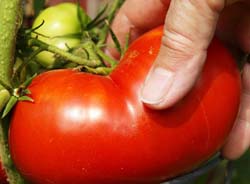
Eat your veggies… but be careful how many of these you eat…
It happens every August. A patient comes in for their regular wellness adjustment and has a concern. The conversation usually goes like this: “Doc, I don’t know what’s going on. I haven’t hurt myself or pushed myself but I woke up this morning feeling achy all over. My knees, back and shoulders hurt like crazy! I feel like an old person.”
After some discussion, we’ll uncover that indeed there was no strain, injury or unusual repetitious event. Finally, I’ll ask if they have eaten tomatoes or potatoes lately. The look I’m given is skeptical and confused. The response goes like this, “Well, yes! My tomatoes are overflowing my garden. I’ve been eating them like apples!”
Hmmmm. So here I am, a chiropractor. Our patients know we don’t treat their symptoms; we help their spine align so the body can heal itself. Patients value regular adjustments to help their bodies stay balanced and heal optimally. Care is about overall wellness. Yet, they have an odd moment of discomfort. They are asking me to fix them. And then here I go asking about tomatoes?
I first read about nightshades (the class of “vegetables” containing tomatoes, white potatoes, red and green peppers, and eggplant) more than 12 years ago in the book “Food and Healing” by Annemarie Colbin. I found it interesting that this group of “vegetables” (they are actually fruits and potato is a tuber) could cause inflammation and achiness in the body. The nightshades contain solanine, which is a glycoalkaloid poison that can cause a toxic effect in susceptible people. Symptoms can include arthritis, calcium depletion, stiff joints and painful knees, ankles and wrists. It can even cause GERD symptoms (heartburn.)
Like most nutritional information I come across, I decided to test it for myself before educating patients. I did an old-fashioned “elimination diet” to test how my body reacted to nightshades. This meant that I ate absolutely no nightshades for two weeks (not even ketchup!). After two weeks, I ate a large amount (think eggplant parmesan for lunch and tomato pizza for dinner), then went to bed. Now remember, I was only 25 years old. I rarely had any pain in my body, and certainly no arthritis, so I didn’t expecte any obvious signs of nightshade sensitivity.
I woke up the next morning feeling like a 95-year-old woman! Every joint in my body seemed to ache. Lying in bed, I was amazed at the ache in my fingers. My neck, shoulders, back and knees all felt like I had done a triathlon the previous day. I slowly got up and showered. Later that morning, I felt nearly normal again. I was so surprised that I retested again the next month. The same thing happened!
It’s not that I no longer eat nightshades. I just make sure that I don’t have too much in one day. If I happen to wake up achy and stiff, I review what I ate the day before. I can always pin it on tomatoes or potatoes. Now I tend to go with the non-nightshade choice. It’s not worth it.
Leading nutritional cleanses in the office, I have patients test nightshades the same way. Not everyone has a reaction like I did, but several people in each group find that nightshades make them achy and stiff. For some people, it’s quite depressing to know their favorite food hurts their body. For others, it’s a huge blessing to finally find a reason for their unexplained pain.
In a study published in the Journal of the International Academy of Preventive Medicine, out of 5,000 arthritis sufferers who eliminated nightshades, 70 percent reported relief from aches, pains and disfigurement.
And yet, how many people with arthritis are taking medication to ease the pain? They have likely never been educated about nightshades. I very rarely have a patient who has heard of the symptomatic effect of foods they eat. Nutrition is much more important than most people realize!
Don’t get me wrong, there are definite nutritional benefits to potatoes and tomatoes (and the rest of the nightshades). They are high in potassium and go well with animal foods because they aid in the digestion of fatty proteins.
My recommendation is to test this for yourself. Eliminate nightshades for a minimum of two weeks (by the way, tobacco and Motrin are also nightshades). Then take a day to eat a considerable amount (a good part of each meal). Wait and monitor how you feel. It may take until the next day (likely the morning) to feel the effects. For many of you, you’ll feel the same and have no worries. For others, it may explain a lot. Then it’s up to you to decide how much you want to include nightshades in your diet.
For me? Ketchup… sure! A few breakfast potatoes next to my omelette…probably! Gnocci (potato pasta) in a tomato sauce? No way!
Get More Pain Tips Like These!
This article first appeared in our premier print publication, Live Pain Free®. Every issue of Live Pain Free® keeps you up-to-date on the latest pain relief discoveries and gives you practical tips for becoming and staying healthy and pain free. Ask for a free 30-day trial subscription today and we’ll send you a copy of our 2-CD audio program, The Complete Healing Formula for Back Pain – a $79 value – just for taking a look.

FREE: Complete Healing Formula + Live Pain Free® Free Trial!


Just want you to know that as a massage therapist fo 26 years, I purchase items for them, to determine if it’s effective before refering them to your site. Please note I don’t have pain. Blessings
Hi,
you saied in your article that thoes 5 foods cause pain in susciptible people, how can i know them? just by exclusion?
i`m confused